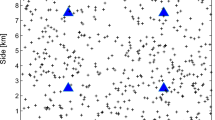Abstract
The release of IEEE 802.15.4 medium access control (MAC) and physical layer specifications represents a significant milestone in promoting deployment of wireless sensor networks. This paper first analyzes the performance of the contention access period (CAP) specified in the IEEE 802.15.4 standard by integrating the discrete-time Markov chain models of the node states and the channel states. Then a modified CAP is analyzed, which could significantly improve the performance of the system. Based on the theoretical analysis of the CAP and the effect of the modification, we have that in the saturated network of IEEE 802.15.4, the collision probability is large, and the throughput is small. The main reasons are the employment of slotted carrier sense multiple access-collision avoidance and the mechanism that if a frame transmission cannot be completed before the end of the CAP, it has to wait until the start of the next CAP. Thus an enhanced collision-avoidance MAC protocol, which achieves a better performance and is compatible with the IEEE 802.15.4 standard, is proposed to improve the performance of the system. Extensive simulations validate our conclusions.
Similar content being viewed by others
References
Park D. H., Kang B. J., Cho K. R., Shin C. S., Cho S. E., Park J. W., Yang W.M. (2011) A study on greenhouse automatic control system based on wireless sensor network. Wireless Personal Communications 56(1): 117–130
Yovanof G. S., Hazapis G. N. (2009) An architectural framework and enabling wireless technologies for digital cities and intelligent urban environments. Wireless Personal Communications 49(3): 445–463
Yu G. J. (2009) Adaptive storage policy switching for wireless sensor networks. Wireless Personal Communications 49(3): 327–346
Simunic D., Djurek M. (2009) Transdisciplinarity of smart health care–transmedical E-volution. Wireless Personal Communications 51(4): 687–695
Kamruzzaman S. M. (2010) An energy efficient multichannel MAC protocol for cognitive radio ad hoc networks. International Journal of Communication Networks and Information Security (IJCNIS) 2(2): 112–119
Padmavathy T. V., Chitra M. (2010) Performance evaluation of energy efficient modulation scheme and hop distance estimation for WSN. International Journal of Communication Networks and Information Security (IJCNIS) 2(1): 44–49
Part 15.4 (2003). Wireless medium access control (MAC) and physical layer (PHY) specifications for low-rate wireless personal area networks (LR-WPANs). IEEESA Standards Board.
Part 15.4b (2007). Wireless medium access control (MAC) and physical layer (PHY) specifications for low Rate wireless personal area networks (WPANs). IEEESA Standards Board.
Kleinrock L., Tobagi F. (1975). Packet switching in radio channels—part I—carrier sense multiple-access modes and their throughput-delay characteristics. IEEE Transactions on Commununications 23:1400–1416 [legacy, pre-1988]
Bianchi G. (2000) Performance analysis of the IEEE 802.11 distributied coordination function. IEEE Transactions on Selected Areas 18(3): 535–547
Pollin, S., Ergen, M., Ergen, S. C., Bougard, B., Catthoor, F., Bahai, A., & Varaiya, P. (2008). Performance analysis of slotted carrier sense IEEE 802.15.4 Acknowledged Uplink Transmissions. In Proceedings of IEEE WCNC (pp. 1559–1564).
He J. H., Tang Z., Chen H. H., Zhang Q. (2009) An accurate and scalable analytical model for IEEE 802.15.4 slotted CSMA/CA networks. IEEE Transactions on Wireless Commununications 8(1): 440–448
Wen H., Lin C., Chen Z. J., Yin H., He T., Dutkiewicz E. (2009) An improved Markov model for IEEE 802.15.4 slotted CSMA/CA mechanism. Journal of Computer Science and Technology 24(3): 495–504
Jung C. Y., Hwang H. Y., Sung D. K., Hwang G. U. (2009) Enhanced Markov chain model and throughput analysis of the slotted CSMA/CA for IEEE 802.15.4 under unsaturated traffic conditions. IEEE Transactions on Vehicular Technology 58(1): 473–478
Huang Y. K., Pang A. C., Hung H. N. (2008) An adaptive GTS allocation scheme for IEEE 802.15.4.. IEEE Transactions on Parallel and Distributed Systems 19(5): 641–651
Cho J., An S. (2009) An Adaptive Beacon Scheduling Mechanism Using Power Control in Cluster-TreeWPANs. Wireless Personal Communications 50(2): 143–160
Harthikote-Matha, M., Banka, T., & Jayasumana, A. P. (2007). Performance degradation of IEEE 802.15.4 slotted CSMA/CA due to hidden nodes. In Proceedings of IEEE LCN (pp. 264–266). Los Alamitos, CA, USA: IEEE Computer Society. http://doi.ieeecomputersociety.org/10.1109/LCN.2007.134.
Hwang, L. J., Sheu, S. T., Shih, Y. Y. & Cheng, Y. C. (2005). Grouping strategy for solving hidden node problem in IEEE 802.15.4 LR-WPAN. In Proceedings of Wireless Internet (pp. 26–32). Los Alamitos, CA, USA: IEEE Computer Society. http://doi.ieeecomputersociety.org/10.1109/LCN.2007.134.
Zheng, J., & Lee, M. J. (2006). A Comprehensive Performance Study of IEEE 802.15.4. Sensor Network Operations (Vol. 4, pp. 218–237). IEEE Press, Wiley InterScience.
Lee B. H., Wu H. K. (2009) Study on a delayed backoff algorithm for IEEE 802.15.4 low-rate wireless personal area networks. IET Communications 3(7): 1089–1096
Ha J. Y., Kim T. H., Park H. S., Choi S., Kwon W. H. (2007) An enhanced CSMA-CA algorithm for IEEE 802.15.4 LR-WPANs. IEEE Communications Letters 11(5): 461–463
Bhatti, G., Mehta, A., Sahinoglu, Z., Zhang, J., & Viswanathan, R. (2008). Modified beacon-enabled IEEE 802.15.4 MAC for lower latency. In Proceedings of IEEE Globecom (pp. 1–5).
Zhu, J., Tao, Z., & Lv, C. (2011). Performance evaluation of IEEE 802.15. 4 CSMA/CA scheme adopting a modified LIB model. Wireless Pers. Commun., Online first: http://www.springerlink.com/content/712431107jwx1h66/fulltext.pdf.
Author information
Authors and Affiliations
Corresponding author
Additional information
Part of this paper has been published in Pro. IEEE VTC2010-fall with the title “An Enhanced Collision-Avoidance MAC Protocol for IEEE 802.15.4”.
Rights and permissions
About this article
Cite this article
Wang, F., Li, D. & Zhao, Y. On Analysis of the Contention Access Period of IEEE 802.15.4 MAC and its Improvement. Wireless Pers Commun 65, 955–975 (2012). https://doi.org/10.1007/s11277-011-0321-8
Published:
Issue Date:
DOI: https://doi.org/10.1007/s11277-011-0321-8




